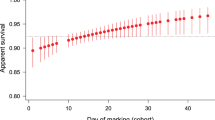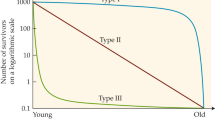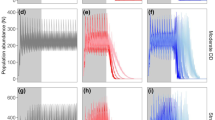Abstract
Age-specific mortality rates decelerate at older ages in laboratory populations in the MedflyCeratitis capitata. This has been interpreted by Careyet al. (1992) to reflect a slowing of the aging process, but might also be explained by declining adult density. Here it is argued that the density explanation, as presented by Graves and Mueller (1993), is unpersuasive for several reasons: extrapolations fromDrosophila to Medflies are unjustified; the range of densities they studied is 2–120 times higher than that used in other studies; they ignore data on Medflies held in isolation, which rule out density effects; their own data suggest that initial cohort density has no effect on mortality rates at older ages, which is the relevant part of the life cycle; their experiment is too small to provide accurate estimates of mortality; new Medfly experiments executed at multiple densities show decelerating and then declining mortality rates at advanced ages for all densities. WhenDrosophila survivorship experiments are done on a sufficiently large scale they also show a deceleration of mortality at older ages that is not attributable to density effects. The deceleration of mortality rates is most likely a real facet of aging, and will have to be taken into consideration in any synthesis of the genetics and evolution of aging.
Similar content being viewed by others
References
Carey, J.R., P. Liedo, D. Orozco & J.W. Vaupel, 1992. Slowing of mortality rates at older ages in large med fly cohorts. Science 258: 457–461.
Curtsinger, J.W., H.H. Fukui, D.R. Townsend & J.W. Vaupel, 1992. Demography of genotypes: Failure of the limited life-span paradigm inDrosophila melanogaster. Science 258: 461–463.
Fukui, H.H., L. Xiu & J.W. Curtsinger, 1993. Slowing of age-specific mortality rates inDrosophila melanogaster. Exp. Geron. 28: 585–599.
Graves, J.L. & L.D. Mueller, 1993. Population density effects on longevity. Genetica 91: 99–109.
Khazaeli, A.A., L. Xiu & J.W. Curtsinger, 1995a. Effect of adult cohort density on age-specific mortality inDrosophila melanogaster. Exp. Geron., in press.
Khazaeli, A.A., L. Xiu & J.W. Curtsinger, 1995b. Effect of adult cohort density on age-specific mortality inDrosophila melanogaster: A density-supplementation experiment. In review.
Nusbaum, T.J. J.L. Graves, L.D. Mueller & M.R. Rose, 1993. Letters to Science. Science 260: 1567.
Pearl, R. & S.L. Parker, 1922. Experimental studies on the duration of life. V. On the influence of certain environmental factors on duration of life inDrosophila. Amer. Natur. 56: 385–405.
Vaupel, J.W., J.R. Carey & P. Liedo, 1994. Medfly mortality decline not due to declining density. Submitted.
Author information
Authors and Affiliations
Rights and permissions
About this article
Cite this article
Curtsinger, J.W. Density and age-specific mortality. Genetica 96, 179–182 (1995). https://doi.org/10.1007/BF01439569
Received:
Accepted:
Issue Date:
DOI: https://doi.org/10.1007/BF01439569




